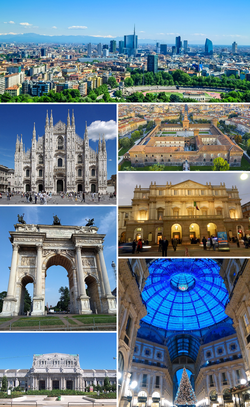Milan
Milan
Milano (Italian) | |
|---|---|
| Comune di Milano | |
 Clockwise from top: Porta Nuova, Sforza Castle, La Scala, Galleria Vittorio Emanuele II, Milano Centrale railway station, Arch of Peace and Milan Cathedral. | |
| Coordinates: 45°28′01″N 09°11′24″E / 45.46694°N 9.19000°E | |
| Country | |
| Region | |
| Metropolitan city | Milan (MI) |
| Government | |
| • Type | Strong Mayor–Council |
| • Mayor | Giuseppe Sala (EV) |
| • Legislature | Milan City Council |
| Area | |
| • Comune | 181.76 km2 (70.18 sq mi) |
| Elevation | 120 m (390 ft) |
| Population (1 January 2022)[1] | |
| • Comune | 1,371,498 |
| • Density | 7,500/km2 (20,000/sq mi) |
| • Metro | 4,336,121 |
| Demonym(s) | Milanese Meneghino[3] |
| Time zone | UTC+1 (CET) |
| • Summer (DST) | UTC+2 (CEST) |
| Area code | 0039 02 |
| Website | www.comune.milano.it |
Milan (Italian: Milano; ancient Medhelan Mediolanum (City in the middle of the lands)) is a city in northern Italy. Milan is the capital of the Milano Provence and of the Lombardy Region. It is populated by 1,371,498 inhabitants. It is the most populated province in Italy, and it is the second biggest city in Italy (after Rome).
Milan is the fashion capital of the world and its important influence on design, economics, opera, and the media make it amongst the world's top 18 Global cities, along with Moscow, Buenos Aires and Kuala Lumpur.
History[change | change source]
Mediolanum was founded by Insubres, a Celtic people. It was captured by the Romans in 222 BC. Milan became very successful under the Roman Empire.
Milan was ruled by the Spanish in the 1500s and the Austrians in the 1700s. During the Renaissance and the Romantic periods, Milan was a major cultural center in the whole of Europe, famous for its literature and opera.
During the war, the city was badly affected by Allied bombings and during the 50s and 60s the city grew into being the wealthy and industrial metropolis it is today.
References[change | change source]
- ↑ "Resident Population on 1st January: All Municipalities". I.Stat. OECD. Archived from the original on 16 May 2019. Retrieved 24 July 2022.
- ↑ "Database". ec.europa.eu. Eurostat. Archived from the original on 16 September 2015. Retrieved 8 January 2020. click General and regional statistics / Regional statistics by typology / Metropolitan regions / Demography statistics by metropolitan regions / Population on 1 January by broad age group, sex and metropolitan regions (met_pjanaggr3)
- ↑ In reference to the Meneghino mask.





